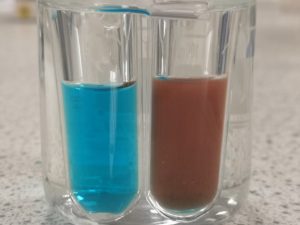 Starch is a condensation polymer made from glucose monomer units. When these large starch molecules react with water they break down into smaller sugar molecules. The starch is said to be hydrolysed. We can tell if starch has been hydrolysed by testing for the small sugar molecules that are formed in the process. This can be achieved by heating the reaction mixture with Benedict’s solution. Benedict’s solution is blue but turns cloudy orange if certain sugar molecules† are present.
Starch is a condensation polymer made from glucose monomer units. When these large starch molecules react with water they break down into smaller sugar molecules. The starch is said to be hydrolysed. We can tell if starch has been hydrolysed by testing for the small sugar molecules that are formed in the process. This can be achieved by heating the reaction mixture with Benedict’s solution. Benedict’s solution is blue but turns cloudy orange if certain sugar molecules† are present.
Starch hydrolysis is a very slow reaction but it can be speeded up by using an enzyme or an acid as catalyst.
The aim of this experiment is to hydrolyse starch in the presence of either an enzyme or an acid and to demonstrate that the enzyme or acid catalyses the reaction.
† Not all sugars give a positive test with Benedict’s solution but those formed in starch hydrolysis do.



